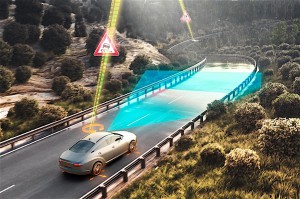
Continental AG's new Road Condition Observer uses sensors to determine the level of grip tires have on the road in different conditions.
Continental AG, the big German supplier that played a key role in the introduction of driver assistance technology such as cross traffic alerts and lane departure warnings by several automakers, has unveiled a new system to help reduce accidents during bad weather.
Called Road Condition Observer, the system utilizes a specially developed algorithm that detects the typical features for the four different road conditions: dry, wet, snow-covered and icy.
“We use sensors available in the vehicle for the Road Condition Observer to gain information on the grip of the road surface,” said Jeremy McClain, head of Systems & Technology for Chassis & Safety at Continental North America.
“This knowledge allows us to adjust the functions of assistance and automated driving systems to the current road conditions. For example, to prevent an impending collision, automatic emergency braking must be initiated earlier on a wet road than on a dry road,” he said.
(Continental unveils fingerprint-based ignition system. Click Here for a look.)
McClain added wet and icy road conditions frequently cause accidents and even experienced drivers can misjudge the level of grip between the tires and the road.
Currently, it is solely the task of drivers to assess the weather conditions and to combine this with observations of the vehicle’s surroundings to draw the correct conclusions about the condition of the road, he noted.
In the future, the Road Condition Observer will support the driver, allowing the assisted and automated driving systems to detect adverse conditions and react appropriately and quickly.
McClain noted the ability to read the road will become more important in the future, as automated driving also requires an accurate judgment of the road conditions. Using this information, an automated vehicle can assess whether a road is icy and warn the driver in case of unsafe road conditions.
For years, the automotive industry has researched ways to detect the available coefficient of friction between tires and the road surface and use this information to make vehicles safer. The key in the Continental system is that it measures the force that a tire can use to grip the road.
Earlier attempts in this field have failed due to inadequate sensors and computing capacity that was either lacking or too expensive.
(Click Here for details about Conti’s autonomous driving system.)
Continental, however, has developed a system that recognizes the road condition and allows a classification of dry, wet, snow-covered and icy road conditions, McClain said.
In addition to the vehicle dynamics sensors in the car, a mono camera is also used. The advantage of this is that Electronic Stability Control is available in nearly every car as standard equipment and mono cameras are available in an increasing number of vehicles due to the growing distribution of driver assistance systems.
The Road Condition Observer classifies the road condition based on the evaluation of the surroundings using camera images from the front of the car, comparison with vehicle dynamics data from the ESC, knowledge of local and regional weather data as well as the tire behavior.
In a subsequent step, a coefficient of friction is can be derived, which will allow the Road Condition Observer to contribute to increasing active driving safety.
In further development, the information of the Road Condition Observer will flow into a comprehensive 360-degree environment model that is a prerequisite for a comprehensive understanding of the overall driving scenario.
“Where possible, such a system should be implemented with the existing sensors. We have already been able to do this with wet road surface detection,” said McClain.
(Continental, Daimler focus on smart vehicle industry. For more, Click Here.)
“In addition to detecting wet roads, in the next stage there will be a vehicle dynamics model integrated into the ESC control unit that detects low friction coefficient values and can optimize the ESC actions accordingly,” he said.

